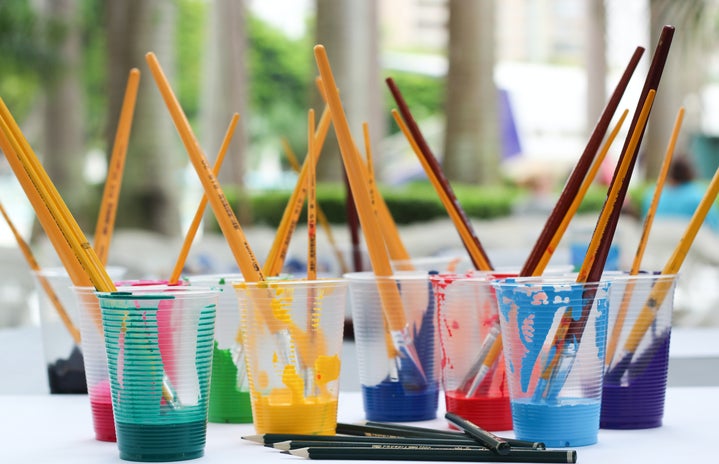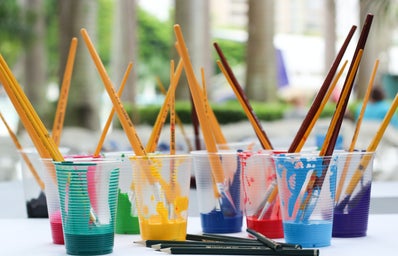Art is a great creative outlet to help you destress, especially if you’re feeling overwhelmed with uni work. If you’ve always wanted to try out oil painting, or maybe just fancy something totally new, read on to learn everything you need to start a new hobby with oil paints.
Materials you’ll need:
If you’re a complete beginner, you don’t really want to spend loads of money on paints and brushes, so the basics will do just fine.
First of all, you’ll need some paint. In my opinion Daler Rowney Georgian Oils are a great brand for beginners: this is because the paints have a good texture, you get a big variety of colours, and they’re not too expensive. One tip I would give you though, is that if you’re planning to do a lot of painting, it would be handy to buy an extra white, as they’re always the first to run out!
In terms of brushes, for beginners you don’t really need to buy all the fancy angled brushes or fan brushes. All you need is a large rectangular-shaped brush, and two round pointy brushes – one medium sized and one really small one for when you need to add detail or sign your name at the end. Some painters like to use palette knives too for creating texture in their painting, but you can make your own with a piece of cardboard!
For paper, any heavy water colour paper will do. You can also use oil paints on canvas, wood, or if you just want to experiment you can just use cardboard – a cereal box maybe? Your palette can be a piece of cardboard too. Anything is fine as long as its not too thin, as the oils will leak through!
Then theres this thing called a medium. It means the liquid which you stir your brush in as you’re going along. Oil paints are oil based, so water will not work with them. There are many different types of oil paint mediums, but I would say the best to use is white spirit. You can buy it from most DIY/crafty places. When you’re doing your painting you just pour a little bit of the medium into a container, like a re-useable jar or bottle, and once you’re finished you can store it for next time. You can also put cling film over your pallette and reuse the paint on it next time.
Putting paint to paper:
Ok, so now you’ve got everything you need, you can finally begin!
But in case you didn’t know, oil paints can stain clothes, so it would be a good idea to wear something that you don’t mind getting ruined.
The first step is to draw out your picture. Use a faint pencil for this, so it isn’t visible through the paint (a B or HB pencil will do). A great drawing tip is to print out the picture you want to paint, and draw a grid on it. The grid size should scale proportionally with the size of your paper/canvas. Then focus on the squares in the grid and draw what you can see in them, its a lot easier than just trying draw the whole thing.
For your first painting it would be good to pick something simple. For example, it’s easier to draw asymmetrical things like leaves and flowers, whereas faces and hands are much more difficult! Also you don’t need to shade or add texture to your drawing, thats what the paints for!
Once you’re happy with your drawing, photocopy it, just incase you make mistakes and want to start over. Then squeeze out the colours you need onto your pallette. Oil paint is quite thick compared to other paints, so use a small amount about the size of a pea. Its also a good idea to work in an area that has a lot of natural light, so you can actually see what colour you’re using.
Its great practice to constantly be looking between your work and the original picture. Look for dark areas in the original picture and paint patches of darker colours on your work – I recently painted a cow, and you can see how I layered up the colours from dark to light in the picture below. This is because its easier to blend light colours over dark, than dark over light.
Then you can build up layers of colours. Don’t worry, theres no special technique of how you should brush the paint onto the paper – use it as if you would any other paint. As you go along you can mix in the medium and paint directly on your painting or on the palette to blend colours together and thin out your paint. Theres no ‘right’ way of doing it so feel free to express your artistic self!
When you finish your painting, congratulate yourself on successfully starting a new hobby and leave it somewhere safe to dry, as oil paints take a long time to dry – I’m talking days!
Happy painting!

